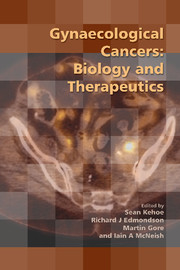Book contents
- Frontmatter
- Contents
- Participants
- Declarations of personal interest
- Preface
- SECTION 1 BIOLOGY OF GYNAECOLOGICAL CANCERS: OUR CURRENT UNDERSTANDING
- SECTION 2 THE TRANSLATION OF BIOLOGY TO THE CLINIC
- SECTION 3 IMAGING AND THERAPY: STATE OF THE ART
- 8 The role of robotics and the future
- 9 ‘Ultra-radical’ surgery in advanced ovarian cancer
- 10 Antivascular therapy in gynaecological cancers
- 11 Oncolytic viral gene therapy in ovarian cancer
- 12 Endometrial cancer: what have the clinical trials taught us?
- 13 Targeting therapies in cancer: opportunities in ovarian cancer
- 14 Functional imaging: from tumour biology to the clinic
- SECTION 4 WHAT QUESTIONS ARE BEING ASKED BY CURRENT CLINICAL TRIALS?
- SECTION 5 CONSENSUS VIEWS
- Index
12 - Endometrial cancer: what have the clinical trials taught us?
from SECTION 3 - IMAGING AND THERAPY: STATE OF THE ART
Published online by Cambridge University Press: 05 February 2014
- Frontmatter
- Contents
- Participants
- Declarations of personal interest
- Preface
- SECTION 1 BIOLOGY OF GYNAECOLOGICAL CANCERS: OUR CURRENT UNDERSTANDING
- SECTION 2 THE TRANSLATION OF BIOLOGY TO THE CLINIC
- SECTION 3 IMAGING AND THERAPY: STATE OF THE ART
- 8 The role of robotics and the future
- 9 ‘Ultra-radical’ surgery in advanced ovarian cancer
- 10 Antivascular therapy in gynaecological cancers
- 11 Oncolytic viral gene therapy in ovarian cancer
- 12 Endometrial cancer: what have the clinical trials taught us?
- 13 Targeting therapies in cancer: opportunities in ovarian cancer
- 14 Functional imaging: from tumour biology to the clinic
- SECTION 4 WHAT QUESTIONS ARE BEING ASKED BY CURRENT CLINICAL TRIALS?
- SECTION 5 CONSENSUS VIEWS
- Index
Summary
Introduction
Endometrial cancer is the fourth most common female malignancy in the UK, with 7536 cases diagnosed in 2007. Notably, the age-standardised incidence of endometrial cancer rose by 40% between 1993 and 2007, which was related to several factors but most importantly the rising epidemic of obesity. Owing to the early warning symptom of postmenopausal bleeding, 75% of cases present at an early stage (International Federation of Gynecology and Obstetrics [FIGO] stage I) and in most cases can be managed by surgery alone. However, 25% of patients, particularly those with cancers of high histological grade (type II endometrial cancer) present with more advanced disease. These women are candidates for adjuvant treatment strategies and are at significant risk of disease recurrence. Indeed, there were 1741 deaths due to advanced/recurrent endometrial cancer in the UK in 2008.
In the past decade, a large number of clinical trials have been conducted that have attempted to address several important issues with respect to improving the outcomes in women with endometrial cancer. In this chapter I provide a synopsis of the published and continuing clinical research in several controversial areas, from initial surgical management through adjuvant systemic therapy to the management of recurrent disease.
Surgery at first presentation
In most cases, the initial management of endometrial cancer confined to the uterus should be surgical and consist of total abdominal hysterectomy (TAH), bilateral salpingo-oophorectomy (BSO) and inspection of the abdominal cavity with peritoneal washings.
Keywords
- Type
- Chapter
- Information
- Gynaecological CancersBiology and Therapeutics, pp. 153 - 166Publisher: Cambridge University PressPrint publication year: 2011



